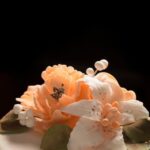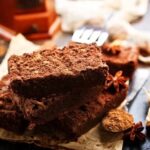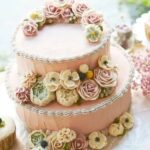Using real flowers to decorate cakes adds a touch of elegance and natural beauty that cannot be achieved with artificial decorations. In this article, we will explore how to use real flowers to enhance your cake designs, creating stunning and visually appealing creations that are sure to impress.
The keyword “how to use real flowers to decorate cakes” is essential for those looking to add a unique and fresh element to their baking projects. Choosing the right flowers is crucial when it comes to cake decoration, taking into account factors such as freshness, toxicity, and aesthetics. By following proper guidelines in selecting the perfect blooms, you can ensure a safe and visually pleasing cake design.
Preparing the flowers for cake decoration involves careful cleaning, trimming, and conditioning to ensure they are safe for consumption and free from contaminants. Different methods can be used to incorporate these delicate blooms into your cake designs, whether using whole flowers, petals, or clusters strategically placed for a beautiful effect on your creation. Stay tuned as we delve deeper into the art of decorating cakes with real flowers in the upcoming sections of this article.
Choosing the Right Flowers for Cake Decoration
When it comes to using real flowers to decorate cakes, choosing the right flowers is essential. Freshness, toxicity, and aesthetics are important factors to consider when selecting flowers for cake decoration. First and foremost, it is crucial to choose fresh flowers that have not been treated with any chemicals or pesticides. This ensures that they are safe for consumption and will look vibrant on your cake.
In addition to freshness, it is essential to be aware of the toxicity of certain flowers. Some flowers are not safe for consumption and can be harmful if ingested. Before using any flower on a cake, make sure to research whether it is edible or toxic. Stick to popular edible flowers such as roses, violets, pansies, and lavender to ensure the safety of your cake.
Furthermore, aesthetics play a significant role in choosing the right flowers for cake decoration. Select flowers that complement the overall design of your cake and match the color scheme you have in mind. Consider the size and shape of the flowers as well as their compatibility with the other elements on the cake. By carefully selecting fresh, non-toxic, and visually appealing flowers, you can create stunning floral designs on your cakes that will impress anyone who sees them.
Ensuring Freshness
When choosing fresh flowers for decorating cakes, it is important to select blooms that are at their peak. Avoid wilting or bruised petals as they will not look attractive on your cake. To ensure freshness, purchase your flowers from a reputable florist or grow them in your own garden if possible.
Avoiding Toxic Flowers
Some common garden flowers may look beautiful but can be toxic when consumed. Always research which flowers are safe for use in food decoration before adding them to your cake. Opt for organic or pesticide-free options whenever possible to minimize any risks associated with toxicity.
Preparing the Flowers for Cake Decoration
Fresh flowers are a beautiful and elegant way to decorate cakes for special occasions. However, it is essential to properly prepare the flowers before using them as cake decorations to ensure they are safe for consumption. Here is a step-by-step guide on how to clean, trim, and condition real flowers for cake decoration:
- Start by selecting fresh, organic flowers that are free from pesticides or chemicals. It is important to choose blooms that are non-toxic and safe for consumption.
- Gently clean the flowers by removing any dirt or debris. You can do this by lightly brushing off any excess soil or rinsing the flowers under cold water. Be careful not to damage the delicate petals.
- Trim the stems of the flowers to an appropriate length for your cake design. Cut the stems at an angle to allow for better water absorption if you plan on placing them in water tubes or vials before inserting them into the cake.
- Condition the flowers by placing them in a vase of water and storing them in a cool place for a few hours. This will help hydrate the flowers and keep them looking fresh and vibrant when used as cake decorations.
By following these simple steps, you can ensure that your real flowers are clean, trimmed, and well-conditioned for decorating cakes in a safe and visually appealing way.
Remember, proper preparation of real flowers is key to creating stunning floral designs on cakes that will impress your guests. With these tips on cleaning, trimming, and conditioning fresh blooms, you can elevate your cake decorating skills and learn how to use real flowers beautifully in your creations.
Methods for Safely Incorporating Flowers Into Cake Designs
Using real flowers to decorate cakes can truly elevate the overall look and feel of your creations. Whether you are a professional baker or an amateur cake decorator, there are various ways you can incorporate fresh blooms into your designs. In this section, we will explore different methods for safely incorporating flowers into cake designs, including using whole flowers, petals, and clusters.
When choosing to use whole flowers on cakes, it is essential to consider the size and shape of the blooms. Opt for smaller flowers that are proportional to the size of your cake to ensure a balanced and visually appealing design. Before placing whole flowers directly onto the cake, make sure to clean them thoroughly by gently washing with water to remove any dirt or pesticides.
Another popular way to use real flowers in cake decorating is by scattering petals or flower clusters on top of the cake. This method adds a delicate and whimsical touch to your design. When using petals or clusters, be mindful of any potential toxicity issues with certain flowers. It is crucial to only choose edible flowers that are safe for consumption when decorating food items like cakes.
Overall, incorporating real flowers into cake designs can bring a natural and organic aesthetic that is both beautiful and elegant. By following proper cleaning procedures, selecting non-toxic blooms, and carefully arranging them on your cakes, you can create stunning creations that will leave a lasting impression on your guests.
| Method | Description |
|---|---|
| Whole Flowers | Select smaller proportional blooms and clean them before placing on cakes. |
| Petals/Clusters | Add a delicate touch by scattering petals or flower clusters while ensuring they are edible. |
Edible Flowers vs Non-Edible Flowers
When it comes to using real flowers to decorate cakes, one important consideration is whether the flowers are edible or non-edible. Edible flowers are safe for consumption and can be used directly on cakes without any concerns. Non-edible flowers, on the other hand, may contain toxins or pesticides that make them unsuitable for direct contact with food. It’s crucial to know the difference between these two types of flowers to ensure the safety of your cake decorations.
To help you navigate through this distinction, here are some examples of popular edible flowers that you can use to decorate cakes:
- Roses
- Violets
- Lavender
- Pansies
On the other hand, here are some common non-edible flowers that should be avoided when decorating cakes:
- Daffodils
- Hydrangeas
- Calla lilies
- Foxgloves
Knowing which flowers are safe for decorating will not only enhance the visual appeal of your cakes but also ensure that they are safe for consumption. So, next time you plan to use real flowers on your cakes, remember to consider whether they are edible or non-edible.
Techniques for Arranging Flowers on Cakes
Decorating cakes with real flowers can create stunning and unique designs that are sure to impress any guest. When it comes to arranging flowers on cakes, there are several techniques you can use to ensure a visually appealing and safe outcome. From placement to spacing to design considerations, let’s explore how you can effectively incorporate real flowers into your cake decorating.
Placement
When it comes to placing flowers on cakes, it’s essential to consider the overall design of the cake. Think about where you want the focal point of the arrangement to be and place your flowers accordingly.
You can opt for a cascading effect down the side of the cake, a cluster of blooms on top, or even a simple single flower strategically placed for an elegant touch. Experiment with different placements to see what works best for your specific cake design.
Spacing
Proper spacing is key when arranging flowers on cakes. You want to make sure that the flowers are evenly distributed throughout the design without overcrowding or overwhelming the cake. Leave enough space between each bloom to allow them to stand out individually while still creating a cohesive arrangement. Consider using different sizes and types of flowers to add interest and variety while maintaining balanced spacing.
Design Considerations
When designing your floral arrangement on a cake, take into account the color scheme, theme, and style of the event or celebration. Choose flowers that complement the overall look of the cake and enhance its aesthetic appeal. Consider incorporating greenery, filler flowers, or decorative elements like berries or herbs for added texture and dimension. Pay attention to details like symmetry, balance, and proportion to create a visually pleasing design that truly shines.
By following these techniques for arranging flowers on cakes – paying attention to placement, spacing, and design considerations – you can create show-stopping confections that are as beautiful as they are delicious. Experiment with different flower varieties, colors, and arrangements to find what works best for your unique creations. With practice and creativity, you’ll master the art of using real flowers in cake decorating in no time.
Tips for Securing Flowers on Cakes
When it comes to using real flowers to decorate cakes, one important aspect to consider is how to securely attach the flowers onto the cake. This is crucial not only for aesthetic reasons but also for food safety. There are several tips and techniques that can be used to ensure that the flowers stay in place and do not contaminate the cake.
One common method for securing flowers on cakes is by using edible adhesive. This can be a simple syrup, piping gel, or even melted chocolate. These adhesives not only help the flowers stick to the cake but are also safe for consumption. It’s important to apply the adhesive sparingly and strategically so that it does not overpower the natural beauty of the flowers.
In addition to edible adhesives, you can also use supports such as floral picks or toothpicks to hold larger or heavier flowers in place on the cake. Be sure to insert these supports into the base of the flower and then gently press them into the cake at an angle. This will provide extra stability and prevent the flowers from toppling over. If using non-edible support materials, always make sure they are removed before serving the cake.
Final Touches and Presentation
The final touches and presentation of a cake can truly make it stand out and become a showstopper at any event. When using real flowers to decorate cakes, it is essential to pay attention to the little details that will elevate the overall look of your creation.
One key aspect to consider is color coordination between the flowers and the frosting or cake itself. By choosing complementary or contrasting colors, you can create a visually appealing design that is sure to impress.
In addition to color coordination, the placement of the flowers on the cake is crucial for achieving a balanced and harmonious look. Consider the size and shape of each flower when arranging them on the cake – larger blooms can serve as focal points while smaller ones can be used as fillers to enhance the overall design. Be mindful of spacing between flowers to prevent overcrowding or gaps that may disrupt the aesthetic flow.
Furthermore, incorporating greenery along with your flowers can add depth and texture to your cake decoration. Sprigs of fresh herbs like rosemary or thyme can complement floral arrangements beautifully and provide a unique touch to your design. Remember that less is often more when it comes to decorating with real flowers; a few carefully chosen blooms arranged thoughtfully can create a stunning visual impact on your cake.
| Tip for Cake Decoration | Description |
|---|---|
| Color Coordination | Choose complementary or contrasting colors between flowers and cake for an visually appealing design. |
| Placement | Consider size, shape, and spacing when arranging flowers on cakes for a balanced look. |
| Add Greenery | Incorporate fresh herbs like rosemary or thyme along with flowers for added texture and depth. |
Conclusion
In conclusion, utilizing real flowers as a decorative element for cakes can truly elevate the overall aesthetic and appeal of your creations. The natural beauty and elegance that fresh blooms bring to cake designs are unmatched, adding a touch of sophistication and charm that artificial decorations simply cannot replicate. By carefully selecting, preparing, and arranging real flowers on cakes, you can create stunning masterpieces that will be sure to impress any guest or client.
When it comes to choosing the right flowers for cake decoration, it is essential to consider factors such as freshness, toxicity, and aesthetics. Ensuring that the flowers are safe for consumption and complement the overall design of the cake is crucial. By following proper cleaning, trimming, and conditioning techniques, you can enhance the longevity and appearance of the flowers on your cakes.
To safely incorporate real flowers into your cake designs, there are various methods you can explore, including using whole flowers, petals, or clusters. Understanding the difference between edible and non-edible flowers is also important in order to prevent any adverse reactions when consuming the final product.
With careful placement, spacing, and design considerations, you can artfully arrange flowers on cakes to create visually stunning creations that are not only delicious but also visually appealing. So next time you’re decorating a cake, don’t hesitate to try incorporating real flowers – they may just be the perfect finishing touch your masterpiece needs.
Frequently Asked Questions
How Do You Attach Real Flowers to a Cake?
Attaching real flowers to a cake can be done by using food-safe flowers that are free from pesticides or chemicals. The best way is to use floral picks or toothpicks to secure the stems in place without contaminating the cake.
How Do You Make Real Flowers Last on a Cake?
Making real flowers last on a cake involves taking steps to ensure their freshness and preventing them from wilting. One way is to keep the flowers hydrated by misting them with water and refrigerating the cake until it’s ready to be served.
Placing a small piece of plastic wrap between the flower and the cake can also help prevent direct contact.
How Do You Decorate a Store Bought Cake With Flowers?
Decorating a store-bought cake with flowers can elevate its appearance easily. Simply arrange fresh, pesticide-free flowers on top of the cake in an aesthetically pleasing design.
Remember to wash the flowers thoroughly and remove any excess stems or leaves before placing them on the cake. This simple touch can transform a plain store-bought cake into a beautiful centerpiece for any celebration.

Welcome to my blog about home and family. This blog is a place where I will share my thoughts, ideas, and experiences related to these important topics. I am a stay-at-home mom with two young children. I hope you enjoy reading it! and may find some helpful tips and ideas that will make your home and family life even better!





